Home Page / Archive Home Page / Remembrance Page / Torches 2018
2017 - New Tower Poppy Initiative launched "Where are they now?"
On 6th September 2017 the ITV News (page also includes a video) announced :
Global search launched to trace poppies from Tower of London installation
A new campaign aims to trace hundreds of thousands of poppies from a famed art project at the Tower of London which marked the centenary of the First World War. The 'Where Are The Poppies Now' project invites members of the public who bought one of the ceramic flowers to 'pin' its location and describe what it represents to them. A total of 888,246 poppies - one for every British military fatality during the conflict - were created by artist Paul Cummins for the Blood Swept Lands And Seas Of Red art installation in 2014. They were planted around the central London landmark in a vast installation that brought huge crowds and helped many to understand the extent of the sacrifice and loss of life during the war. The flowers were then sold to members of the public for £25 each, with profits going to military charities. The end of the art installation saw the ceramic flowers scattered to well-wishers across the world.
Now, digitally at least, they can be reunited through the interactive project, which has been launch by the WWI centenary arts initiative 14-18 Now. Dozens of poppies have already been 'pinned' on the website's map, appearing across Britain as well as in the Netherlands and USA. Many of those who shared their stories said they had bought the flowers as a tribute to servicemen and women in their own family, including many who died in the First World War.
Poppy-owners can take part by visiting www.wherearethepoppiesnow.org.uk.
Here are our two poppies identified on the map with our images providing verification - see below for larger images
My personal contribution as seen on-line - the original story was a little longer and is reproduced in its entirety below
Tell us where your poppy is now and share with others why you bought it and what it means to you.
As soon as I heard about the 2014 Poppy Initiative I was gripped with a curiosity about how this monumental feat was to be accomplished and how it would look when finished. By profession I was a theatre ‘prop’ maker for many years and creating ‘something’ out of ‘nothing’ was one my passions during my working life. I carried it through to home and hobbies and have always recycled everything either in a conventional manner or by creating something different, much of which has been sold over the years to make money for animal charities. The Poppy itself has a great significance here in the UK, being a visible commemoration of the dead, wounded and invalided of WWI but also on a much more personal basis as my heritage lies in Poland. My father, fighting with the Allies, was involved in the Battle for Monte Cassino and seriously wounded during the assault. There was a song written about that battle and one of the telling descriptions within it is that the poppies that then grew on site were so much redder because ‘they drank of spilt Polish blood.’ Although a little macabre when taken out of context, the refrain of the song is always the one sung most loudly. I followed the initiative as one of the national newspapers carried a story about how each flowerhead was made individually and so no two would really be exactly the same. Having never worked with clay on a professional basis I have always loved seeing professionals ‘throw pots’ and ‘blow glass’ and create magic. The making of the poppies, although not ‘thrown’ was equally magical. For me the whole exercise was a visual feast that we were able to follow through the media and the internet thus making it very real experience. For me, the ‘visual’ is always so important and I was not disappointed. Then, happily I heard that the poppies would be sold on completion of the project and as soon as a web link was provided I determined to order one or two (if they would allow) of the poppies for many different reasons. Because I loved them on sight, because I wanted to buy one for my sister who loves poppies and has a very strong sense of nationalistic pride and because I wanted to commemorate my parents in a very personal way. Then came the day that the poppies arrived, delivered with due deference and ceremony by the driver who handed them over with the simple words ‘Mr and Mrs Ludlow, here are your poppies.’ - The image I have provided is a scan of the Letters page in my local paper which featured it at the star letter.
Here is confirmation that my sister Marysia's poppy was planted successfully and her story, like mine had to pared down the full version is reproduced below
Tell us where your poppy is now and share with others why you bought it and what it means to you.
I have loved poppies since I was a very small girl because of their bright colour and the story of how our parents met. My sister, who has always given me birthday cards and presents featuring poppies, gave me my poppy which was a huge surprise. I was fascinated by the Tower Poppies and although I could not visit the exhibition, kept a scrapbook of its progress. I never imagined I would own one of them. Poppies are important to me because Father fought at the Battle of Monte Cassino in May 1944, He was a lieutenant in the Polish Army. In the words of a famous Polish song “The poppies on Monte Cassino are redder still as they grew on soil soaked in Polish blood.” He was seriously wounded when he led an assault on Monte Cassino. He and Mother met in a British Military hospital in Cairo where she was a Polish Red Cross nurse. They married in Egypt and came to England on hospital ships. They were given political asylum and became proud British subjects. My special poppy sits on top of a small glass bowl filled with remembrance poppies I have bought and worn with pride over the years. Finally the poppy reminds me of the sacrifices made by so many so that we could be born and live in Freedom, hope and maybe one day in peace.
This is how the individual stories appear when extended - I really regret using the Dispatch scan on mine, but have made up for it by posting additional images when viewed on the actual page!
If you do a search on the map for your own postcode then the nearest stories will pop up as shown on the two images above - it is entirely unintended (at least I hope it is or it would be too spooky) that my story on left image appears at the top identified as 'J' (don't get me started not on this page anyway) with a 'David' and 'Anna' appearing below! My sister (Krystyna) Marysia appears at the top of her map on the right image identified as 'K'.
Lest we forget!
They say it isn't over until it's over - here is the thank you e-mail received on 9th April 2015
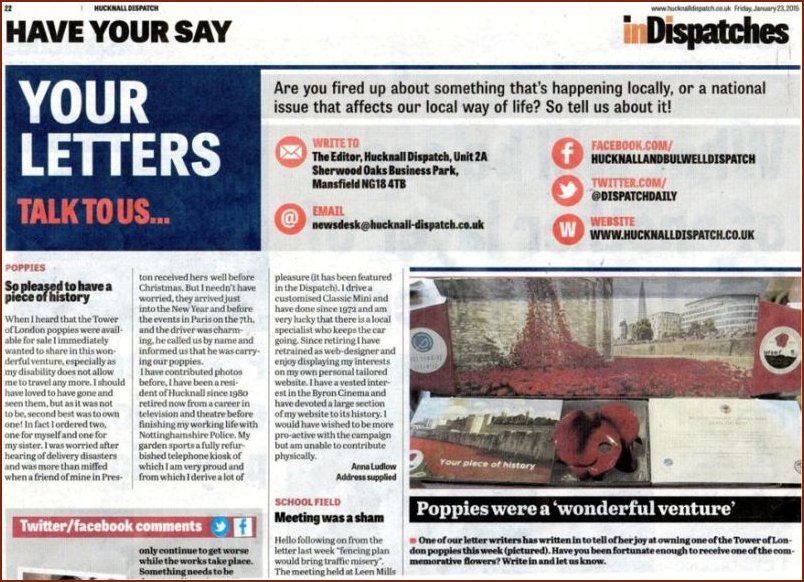
The Hucknall Dispatch features the Poppies and the provenance behind them - I was very pleased that they printed this.
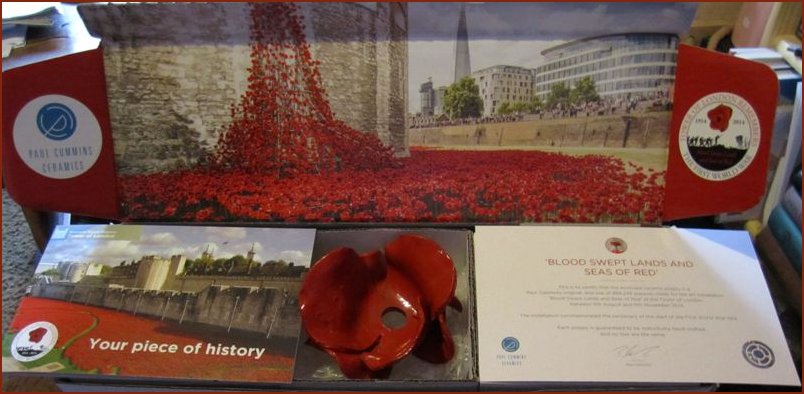
Beautifully presented, my personal poppy arrives without incident

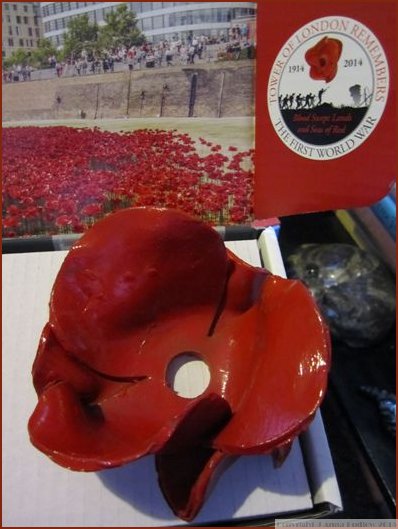
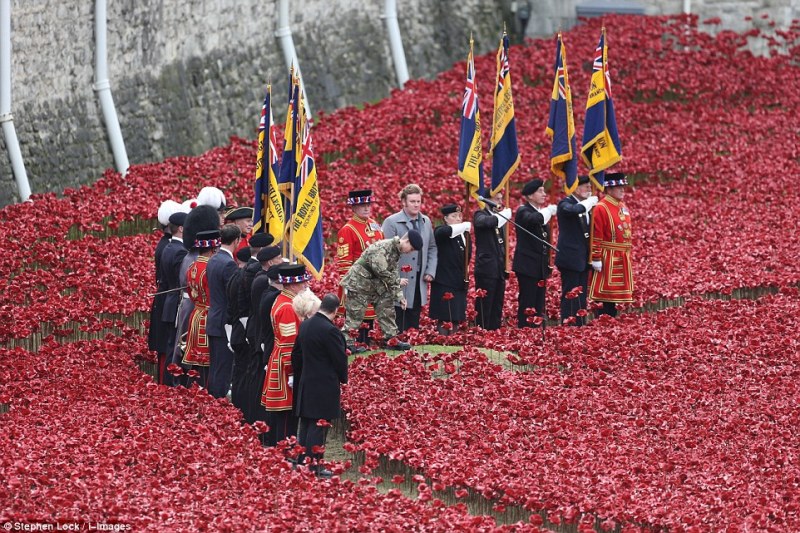
The final poppy being placed just prior to the two minutes silence on Tuesday, 11th November, 2014
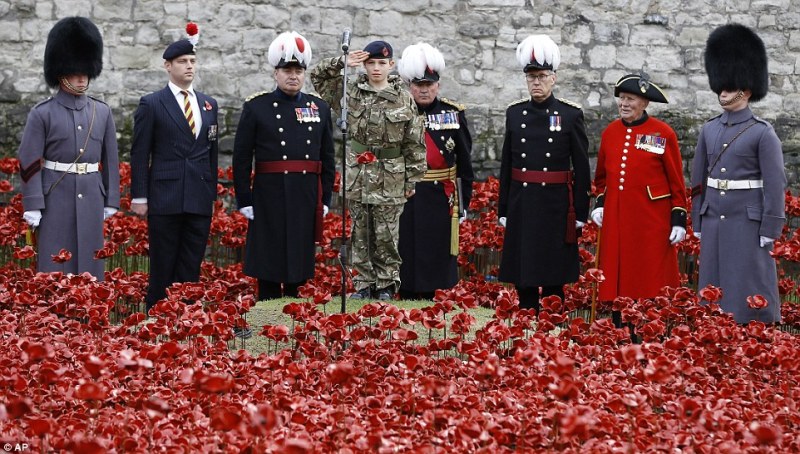
Honour: Cadet Harry Hayes, 13, gives a fine salute after adding the very last ceramic poppy to the Tower of London moat yesterday in front of a line-up of Forces VIPs - with thanks for the image copyright of the Associated Press.
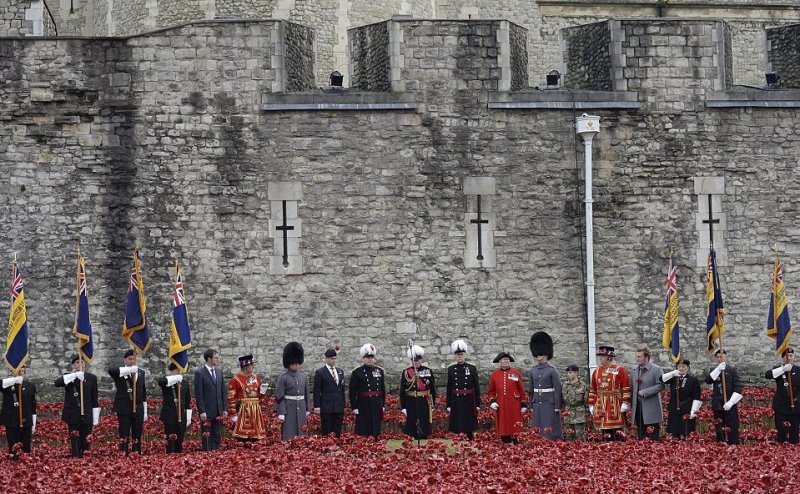
Harry (fifth from right) lined up with other dignitaries at the art installation at the Tower of London for the commemoration - thank you to the © Press Association for this evocative image
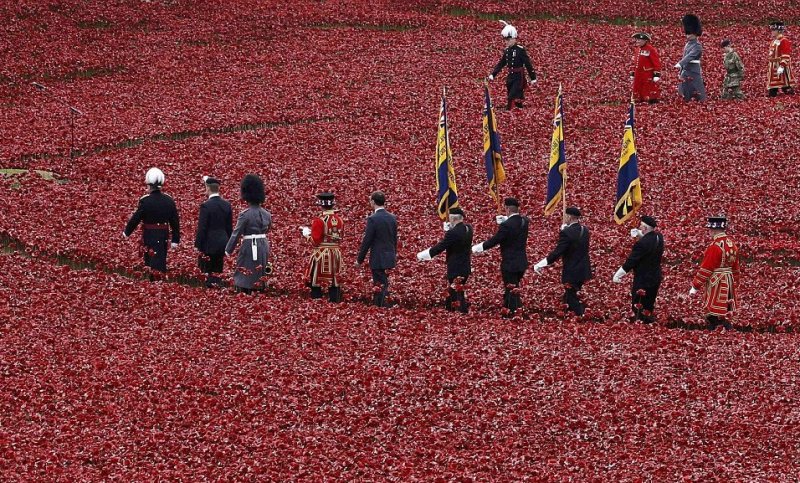
Servicemen walk through each of the 888,245 blooms, which represents a British or Colonial military death during the First World War - with thanks to © Reuters for this memorable image.
My proof of purchase of two Poppies
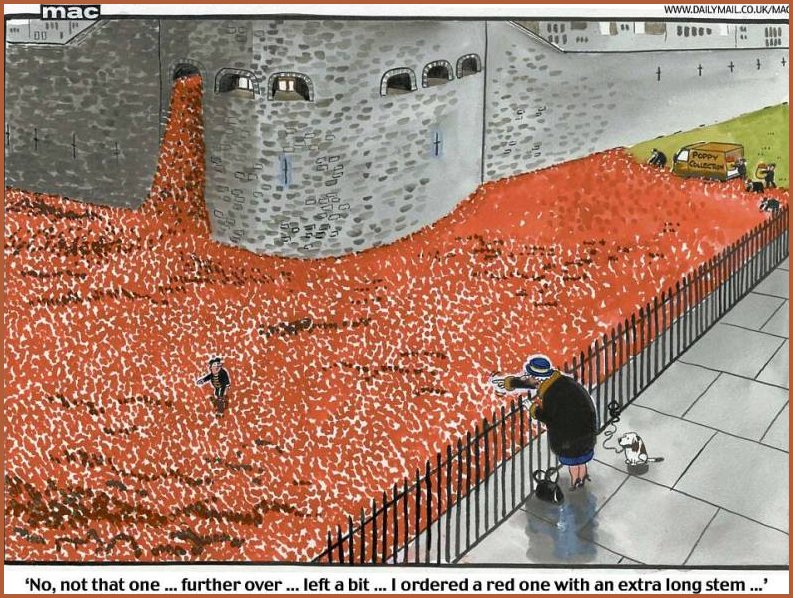
With grateful thanks to Mac and the Daily Mail for this very true to me cartoon! I'm sure, given the choice by being there, this would be me!
With grateful thanks to the Daily Mail for the article reproduced below, Getty Images, Ian McIlgorn, Greg Brennan (header), Lucy Young, Londonist, MPS Helicopters, the Press Association for various images and the Historic Royal Palaces for images and allowing this monument to become a reality!
What's it all about?
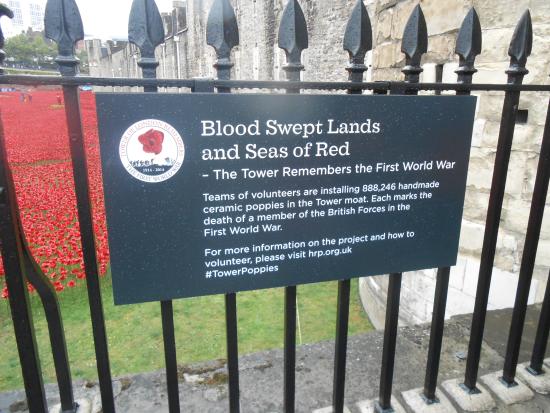

Two separate provenances detailing the information of the exhibition
How do you make 888,246 china poppies? Get fired up - then glaze over! Meet the unsung heroes of the glorious artwork captivating Britain at the Tower tribute to the WWI fallen
888,246 poppies will form the full Tower of London tribute by November 11
Each hand-made china flower represents a soldier who died during WWI
The Mail on Sunday was given a guided tour of factory where they are made
Workers revealed the painstaking process involved in crafting the poppies
Clay is cut and moulded by hand before being blasted in a 1,000C kiln
The sea of red commemorating the fallen that now surrounds the Tower of London is proving overwhelmingly popular with visitors. As Remembrance Day approaches, the 888,246 ceramic poppies – one for each of the Commonwealth soldiers who died in he First World War – offer a focus for reflection on the horrors and sacrifice of conflict.
They have been progressively filling the Tower’s 16-acre dry moat over the summer, with the final one being put in place on November 11. It was the vision of artist Paul Cummins, inspired by an unknown soldier from his home town of Derby. He said: ‘I read through wills of First World War soldiers and came across one man who said everyone he knew had been killed. ‘He wrote of “blood swept lands and seas of red, where angels dare to tread”. It read like a poem and it just seemed to fit.’
Paul, who is studying for a PhD at Derby University, added: ‘This is the biggest thing I have done. ‘I am amazed that people have taken it to heart.’
The Royal Shakespeare Company’s theatrical designer Tom Piper helped realise the vision, and each poppy has been sold for £25, raising millions for Service charities.
But how were they actually created? The Mail on Sunday was given a guided tour of the factory specially set up to make the poppies on an industrial estate in Derby. There, almost 50 workers, most of whom have relatives in the Armed Forces, make the flowers by hand...
Step one: Sliced and squashed
Step one is to slice the blocks of terracotta clay with a bow saw before it is squashed into thin 4mm sheets in an electronic rolling machine.
Step two: Cut like pastry
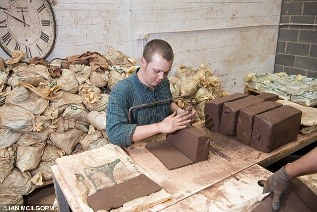
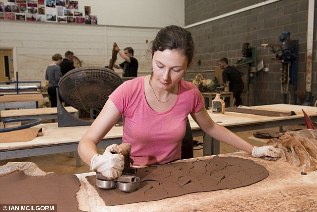
Worker Will Young slices clay so it can be put through a rolling machine and make it thin enough to mould into the correct shape / Michaela Prochazkova stamps petal shapes using cutters at the ceramic poppy factory in Derby
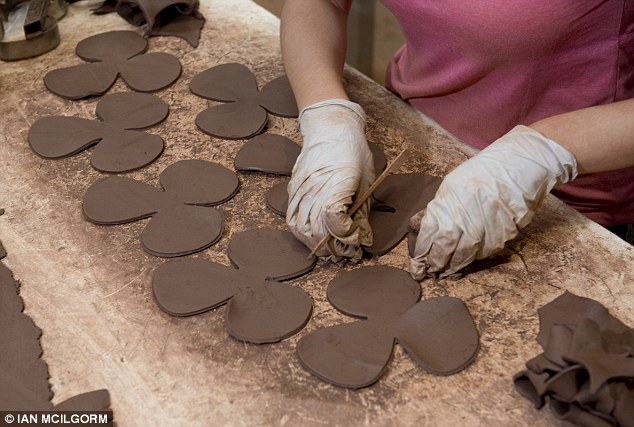
The clay petals are carefully cut out at the factory to make them look as realistic as possible
The shape of the petals are stamped out with cutters, almost like pastry, in two different sizes for the two layers of the flower. Both are clover-like, with three petals.
Step three: A hole lot of work
The two petal shapes are then amalgamated to form the flowers. The workers use the tool above to make a hole manually in the centre of each shape, which are aligned as they connect the layers together.

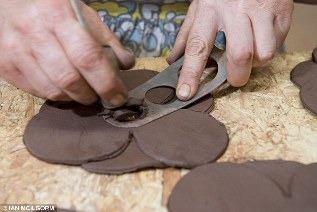
888,246 poppies - one for each WWI Commonwealth fatality - will be installed at the Tower of London memorial by November 11 / Next step: The two petal shapes are amalgamated and a hole in the centre of the poppy is cut out
Step four: The flower blossoms
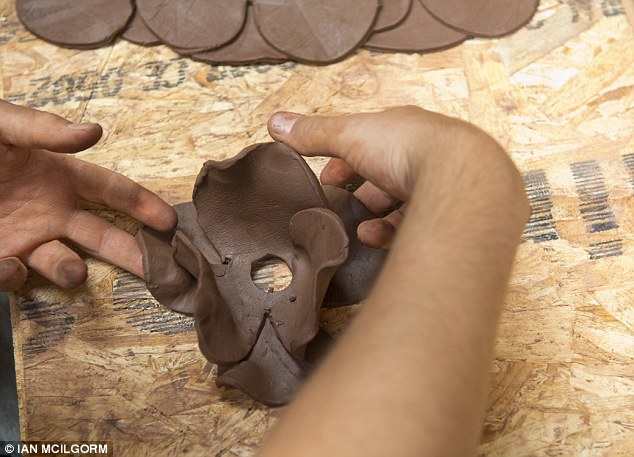
Starting to take shape: The flat shapes are pinched and twisted to make the recognisable flowers
The most difficult part of the process is making the final flower. Each one is different, depending on who makes it.
The petals on the top layer are lifted up, then those behind are manipulated to subtly support them.
Finally the edges of the top petals are squidged together and shaped to make them look more realistic.
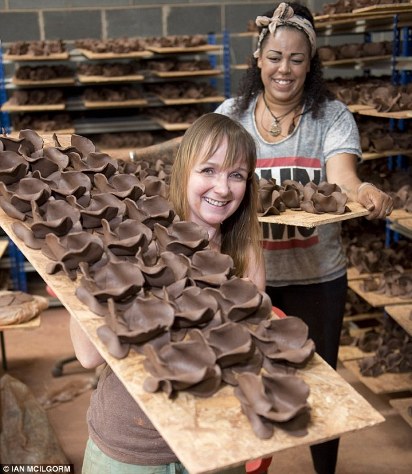
Ms Dennett and Cherelle Bibby make trays of the flowers before popping them on to trays ahead of a blast in a kiln
Step five: You're fired!
The clay flowers are then put on racks around the room for 24 hours until they are ‘leather hard’.
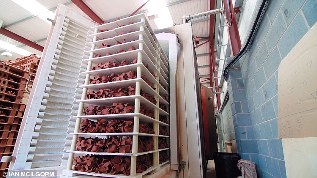
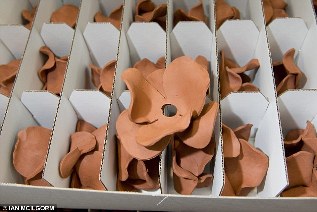
Hundreds of poppies go into the kiln at once, where temperatures will reach upwards of 1,000C / The fired flowers are then boxed before being sent to another facility to be glazed bright red
‘Because the kilns are on all the time, it’s always warm in here,’ says Paul. ‘So the ambient temperature dries them very quickly. ‘The flowers are then put into a kiln for up to eight hours where they are fired up to 1,000C.’
Step six: Double glazing
Finally the flowers are dipped twice into a scarlet glaze – a base coat and a top coat – and placed back into the kiln where they are heated to 1,117C.
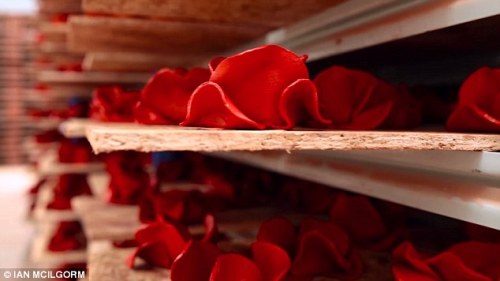
After the glaze, the clay flowers are dried before being sent to the Tower of London to be planted
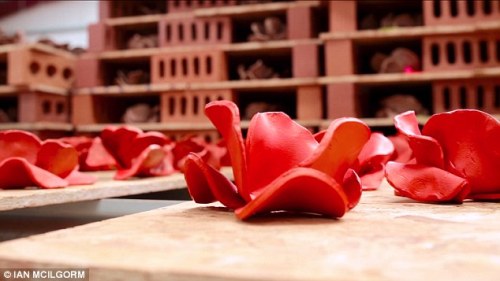
When they have cooled, they are sent to the Tower of London, and put into place, mounted on metal stalks that are stuck into the ground.
Volunteers placing the poppies into their allocated position
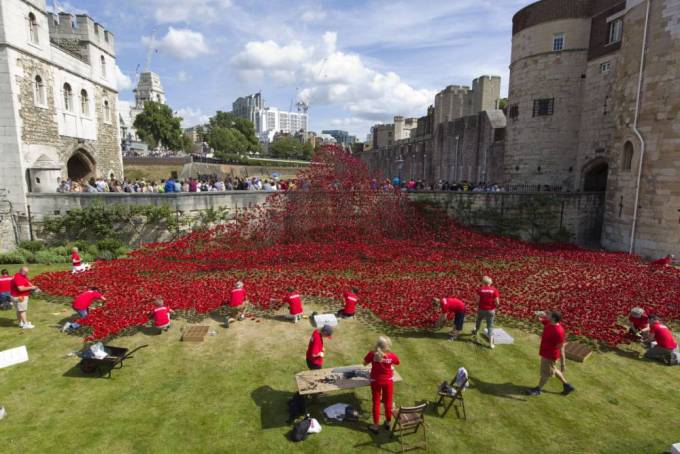
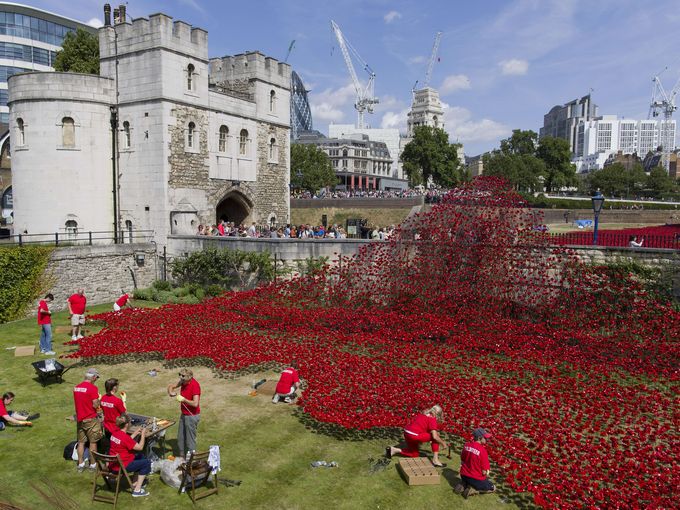
Volunteers having a lot of fun knowing that they are part of placing the outdoor Poppy exhibition phenomenon
In Place for the Her Majesty and her public to view
Her Majesty requested a special viewing of the monument.
The Cambridges (plus newly announced baby-in-waiting) and Prince Harry of Wales also attended.
The night views of the Tower and the poppies is too spectacular not too include!
Two of my friends Carol and Fran were lucky enough to visit - here are their photos :
I think this is Traitor's Gate - what a fabulous photo!
And of course typically disrespectful:
Poppy Artist : I've received death threats
As reported in the Daily Mail on 16th February 2015
Artist who created poppy installation at Tower of London as part of WW1 commemoration reveals he received death threats over it

Paul's achievement rightly recognised with an M.B.E. - with thanks to Getty Images for the beautiful panoramic view.
- Paul Cummins created ceramic poppy installation at the Tower of London
- Mr Cummins made 888,246 poppies with team at Derbyshire workshop
- About £10m from proceeds of selling flowers will go to military charities
- But he has received death threats from people unhappy about donations
- Mr Cummins will announce a new project involving tulips next month
By Claire Carter for MailOnline Published: 10:04, 15 February 2015 | Updated: 15:22, 15 February 2015
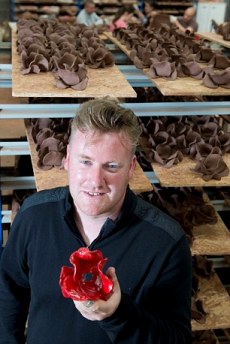 The artist who created the sea of ceramic poppies at the Tower of London has revealed he received death threats over the project.
The artist who created the sea of ceramic poppies at the Tower of London has revealed he received death threats over the project.
Paul Cummins created 888,246 poppies to be placed outside the Tower of London to remember all those who died in World War One for the Blood Swept Lands and Seas of Red installation.
But despite the success of the project, which saw thousands of people visit, Mr Cummins said he has received threatening phone calls and letters after it was announced that some of the proceeds from selling poppies would go to armed forces charities.
Around £10million has been raised for six military charities - including Help for Heroes and the Royal British Legion - from the sale of the poppies, for around £31 each.
But it appeared news of the fund-raising angered some people and Mr Cummins, of Derbyshire, has received threats by email, letter and phone.
'Even the police got involved,' he told the Sunday Times.
'I suppose, because they felt that the money was going to charities which in some way were involved in the war.'
Mr Cummins was made an MBE in the new years honours list for his role making the ceramic poppies for the installation.
It was designed by Tom Piper, at his Derbyshire workshop.
The Tower of London installation earned Mr Cummins such acclaim he has been approached about other similar projects around the world.
"A century after the start of World War I, ceramic artist Paul Cummins and stage designer Tom Piper were recognized for creating a sea of ceramic poppies that filled the moat of the Tower of London in tribute to the war dead. They were made Members of the Order of the British Empire, or MBEs, for creating the work, which was visited by 5 million people, including the queen.
Britain's honors are bestowed by the monarch, but recipients are selected by committees of civil servants from nominations made by the government and the public.
In descending order, the main honors are knighthoods, CBE, OBE and MBE. Knights are addressed as "sir" or "dame," followed by their name. Recipients of the other honors have no title, but can put the letters after their surnames.
The honors are used to reward long-serving politicians, diplomats, civil servants and royal courtiers, but the list also includes a smattering of celebrities and many people unknown outside their communities or specialist fields."
Thanks to the Daily Mail for the 'spot'
One unscrupulous seller (pictured) has already tried to sell the £25 charity poppy for a substantial mark up on its original price
Ebay bans people from trying to sell Tower of London ceramic poppies on the site for profit after listings appear more than double the original price
eBay on alert for people re-selling £25 ceramic charity poppies for profit Tower of London poppy installation raises money for armed forces charities. Listings have already been removed offering to sell the charity poppies
One listing offered to sell a poppy for more than double the original price. Each of the 888,246 poppies represents a British military fatality during WWI
Auction website eBay is on alert to stop people making a profit by re-selling poppies from the Tower of London installation. The ceramic poppies created for the 'Blood Swept Lands and Seas of Red' art project have been so popular that all 888,246 of them have sold in advance for £25 each - raising money for armed forces charities in the process. But it has emerged that some of the ceramic poppies are being sold online for profit."
One seller has listed two ceramic poppies on eBay for £49.99 and £65 - more than double the price. The seller known as '2250leanne' said in the description: 'Please note delivery of this item is due late January, early February 2015'. To add further insult the trader asked up £9.99 for postage - double the official website price. Luckily website bosses spotted the dubious listings and removed them immediately. They have now put a system in place to automatically remove any such listings in the future.
Page refreshed : 25th August 2020 (G)